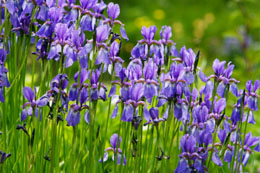Vivid blue/purple to mesmerizing yellow are the colors an Iris, a flower seeped in the Greek mythology, offers to the beholder. Read on to know more about this flower.

The plants in genus
Iris with showy and extravagantly-colored blooms belong to the family
Iridaceae. Natives of North Temperate regions, their habitat ranges from montane regions and grassy slopes, to meadows, riverbanks, and deserts. The elegant purple-colored Iris was designated as the Tennessee State Cultivated Flower by the Legislature in 1933. History and meanings of Iris flowers are very rich and diverse.
Meaning and Symbolism
Traditionally, an Iris flower denotes faith, hope, wisdom, courage, and admiration, but the meaning changes according to the color and geographic region: dark purple (or blue) refers to royalty and wisdom, while the yellow iris denotes passion, and white symbolizes sympathy or remembrance.
Iris takes its name from the Greek word meaning rainbow. It is also the name of the Greek goddess who is the messenger of the gods (sometimes love) and a symbolic representation of the rainbow. In Greek mythology, the Goddess Iris was believed to guide dead women who had purple-colored Irises planted over the graves in their eternal journey. It is also the flower of the birth month February.
How to Grow Iris Flowers
An Iris plant is easy to grow and flower, and quite low on maintenance too. It is propagated through seeds, or through rhizome division and plantation. Division of roots is a much more common way to grow this flower, as seeds have a higher failure rate and take longer to germinate too. Although it is a spring flower, there are varieties that bloom in winter (with a little care and protection from frost), in spring, and in the summers too.
For growing Iris, the soil medium should be porous and properly drained. Try to maintain the soil pH at 6.8, although this plant is tolerant to most soil conditions, except heavy water logging. Plant iris rhizomes that have at least two leaf sprouts. The rhizome tops should be exposed and, depending on the variety, spaced 15 to 24 inches apart. Watering depends on climatic conditions and soil type. Deep watering at long intervals is recommended than frequent watering. A light application of fertilizer about a month before and after the bloom is all that an Iris plant needs. This plant should be thinned every 3-4 years to avoid excessive crowding. Once the bloom has been spent, cut stems close to the ground to promote growth of healthy new leaves.
Iris flower bouquets, either of single-colored flowers or flowers of various colors, look beautiful. These flowers also look good as part of a bouquet made with many flowers. As these flowers and their colors signify or denote specific meanings, they are suitable for many occasions.






 The plants in genus Iris with showy and extravagantly-colored blooms belong to the family Iridaceae. Natives of North Temperate regions, their habitat ranges from montane regions and grassy slopes, to meadows, riverbanks, and deserts. The elegant purple-colored Iris was designated as the Tennessee State Cultivated Flower by the Legislature in 1933. History and meanings of Iris flowers are very rich and diverse.
The plants in genus Iris with showy and extravagantly-colored blooms belong to the family Iridaceae. Natives of North Temperate regions, their habitat ranges from montane regions and grassy slopes, to meadows, riverbanks, and deserts. The elegant purple-colored Iris was designated as the Tennessee State Cultivated Flower by the Legislature in 1933. History and meanings of Iris flowers are very rich and diverse.